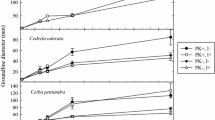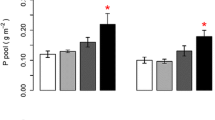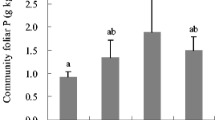Abstract
Afforestation of degraded croplands by planting N2-fixing trees in arid regions is highly recognized. However, fixation of atmospheric nitrogen gas (N2) by woody perennials is often limited on phosphorus (P) poor soils, while any factor limiting N nutrition inhibits tree growth. In a two-factorial field experiment, the effect of three P amendments was examined during 2006–2008 on N2 fixation, biomass production, and foliage feed quality of actinorhizal Elaeagnus angustifolia L. and leguminous Robinia pseudoacacia L. With the 15N natural abundance method, N2 fixation was quantified based on foliar and whole-tree sampling against three non-N2-fixing reference species: Gleditsia triacanthos L., Populus euphratica Oliv., and Ulmus pumila L. The P applications, in March 2006 and April 2007 only, included (i) high-P (90 kg P ha−1), (ii) low-P (45 kg P ha−1), and (iii) 0-P. After 3 years, the average proportion of N derived from atmosphere (Ndfa, %) increased from 78 % with 0-P to 87 % with high P when confounded over both N2-fixing species. With the used density of 5,714 trees ha−1, the total amount of N2 fixed (Ndfa, kg N ha−1) with high-P increased from 64 kg N ha−1 (year 1) to 807 kg N ha−1 (year 3) in E. angustifolia and from 9 kg N ha−1 (year 1) to 155 kg N ha−1 (year 3) in R. pseudoacacia. Total above-ground biomass increases were too variable to be significant. Leaf N content and therewith also leaf crude protein content, which is an indicator for feed quality, increased significantly (24 %) with high-P when compared to 0-P for E. angustifolia. Overall findings indicated the suitability of the two N2-fixing species for afforestating salt-affected croplands, low in soil P. With P-applications as low as 90 kg P ha−1, the production potential of E. angustifolia and R. pseudoacacia, including the supply of protein-rich feed, could be increased on salt-affected croplands.


Similar content being viewed by others
References
Abrol IP, Yadav JSP, Massoud FI (1988) Salt-affected soils and their management. In: FAO soil bulletin 39. FAO, Rome, pp 1–131
Augusto L, Crampon N, Saur E, Bakker MR, Pellerin S, de Lavaissière C, Trichet P (2005) High rates of nitrogen fixation of Ulex species in the understory of maritime pine stands and the potential effect of phosphorus fertilization. Can J Forest Res 35(5):1183–1192
Balasubramanian V, Joshaline CM (1996) The effect of Frankia and VAM inoculation on growth of Casuarina seedlings. In: Wheeler CT, Narayanan R, Parthiban KT, Kesavan A, Surendran C (eds) Proceedings of the national seminar on the root microbiology of tropical nitrogen fixing trees in relation to nitrogen and phosphorus nutrition. Tamil Nadu Agricultural University, Coimbatore, pp 55–59
Binkley D, Senock R, Kermit CJ (2003) Phosphorus limitation on nitrogen fixation by Facaltaria seedlings. Forest Ecol Manage 186:171–176
Boddey RM, Peoples MB, Palmer B, Dart PJ (2000) Use of the 15N natural abundance technique to quantify biological nitrogen fixation by woody perennials. Nutr Cycl Agroecosyst 57:235–270
Brewbaker JL (1989) Nitrogen fixing trees. In: Werner D, Mueller P (eds) Fast growing trees and nitrogen fixing trees. Gustav Fisher Verlag, Marburg, pp 253–262
Close W, Menke KH (1986) Selected tropics in animal nutrition. Manual prepared for the 3rd Hohenheim course on animal nutrition in the tropics and semi-tropics, 2nd edn. Deutsche Stiftung Für Internationale Entwicklung (DSE), p 255
Coe R, Huwe B, Schroth G (2003) Designing experiments and analysing data. In: Schroth G, Sinclair FL (eds) Trees, crops and soil fertility: concepts and research methods. CAB International, Wallingford, pp 39–67
Conrad C, Dech SW, Hafeez M, Lamers JPA, Martius C, Strunz G (2007) Mapping and assessing water use in a Central Asian irrigation system by utilizing MODIS remote sensing products. Irrig Drain Syst 21:197–218
Danso SKA, Zapata F, Awoinake KO (1995) Measurement of biological N2 fixation in field-grown Robinia pseudoacacia L. Soil Biol Biochem 27:415–419
Devendra C (1992) Nutritional potential of fodder trees and shrubs as protein sources in ruminant nutrition. In: Speedy A, Pugliese PL (eds). Legume trees and other fodder trees as protein sources for livestock. FAO, Rome. Anim Prod Health Paper 102: 95–113
Djumaeva D, Djanibekov N, Vlek PLG, Martius C, Lamers JPA (2009) Options for optimizing dairy feed rations with foliage of trees grown in the irrigated drylands of Central Asia. Res J Agric Biol Sci 5:698–708
Dommergues YR (1995) Nitrogen fixation by trees in relation to soil nitrogen economy. Fertil Res 42:215–230
Galiana A, Bouillet JP, Ganry F (2004) The importance of biological nitrogen fixation by trees in agroforestry. In: Rashid S (ed) Symbiotic nitrogen fixation: prospect for enhanced application in tropical agriculture. Science Publishers, Montpellier, pp 185–199
Gillman J, Rosen C (2000) Tree fertilization: a guide for fertilizing new and established trees in the landscape. University of Minnesota. Retrieved from http://www.extension.umn.edu/distribution/horticulture/dg7410.html
Gökkaya K, Hurd TM, Raynal DJ (2006) Symbiont nitrogenase, alder growth, and soil nitrate response to phosphorus addition in alder (Alnus incana ssp. rugosa) wetlands of the Adirondack Mountains, New York State, USA. Environ Exp Bot 55:97–109
Hogberg P (1997) Tansley review no. 95 15N natural abundance in soil–plant systems. New Phyt 137:179–203
Khamzina A, Lamers JPA, Worbes M, Botman E, Vlek PLG (2006) Assessing the potential of trees for afforestation of degraded landscapes in the Aral Sea Basin of Uzbekistan. Agrofor Syst 66:129–141
Khamzina A, Lamers JPA, Vlek PLG (2009) Nitrogen fixation by Elaeagnus angustifolia L. in the reclamation of degraded croplands of Central Asia. Tree Physiol 29:799–808
Lambers H, Shane MV, Cramer MD, Pearse SJ, Veneklaas EJ (2006) Root structure and functioning for efficient acquisition of phosphorus: matching morphological and physiological traits. Ann Bot 98:693–713
Lamers JPA, Khamzina A (2010) Seasonal quality profile and production of foliage from trees grown on degraded cropland in arid Uzbekistan, Central Asia. J Anim Physiol Anim Nutr 94(5):e77–e85. doi:10.1111/j.1439-0396.2009.00983.x
Lamers JPA, Bobojonov I, Khamzina A, Franz J (2008) Financial analysis of small-scale forests in the Amu Darya lowlands of rural Uzbekistan. Forest Trees Livelihoods 18:373–386
Luyindula N, Haque I (1992) Effect of Rhizobium inoculation and phosphorus on growth and nitrogen fixation in tree legumes grown on highland Vertisols. In: Biological nitrogen fixation and sustainability of tropical agriculture. Wiley-Sayce Co-Publication, Chichester, pp 109–112
Lynd JQ, Hanlon EA, Odell GVJ (1984) Nodulation and nitrogen fixation by arrow leaf clover: effects of phosphorus and potassium. Soil Biol Biochem 16:589–594
MacDicken KG (1993) Inoculation of forest trees: the use of Rhizobium, Frankia and Mycorrhiza. Occasional paper, 20. Food and Agriculture Organization of the United Nations (FAO), FORSPA, Bangkok, p 40
Marschner H (1986) Mineral nutrition of higher plants. Academic press, New York, p 674
MAU (1982) Recommendations on fertilizer use in kolkhozes and sovkhozes in Uzbekistan. Ministry of Agriculture of Uzbekistan, Tashkent
Ministry of Agriculture and Water Resources of Uzbekistan (MAWR) (2010) Land and water use values for Uzbekistan for 1992–2009. MAWR, Tashkent
Musaev BS (2001) Agrochemistry. Shark, Tashkent, p 81 (in Uzbek)
Oliet JA, Planelles R, Artero F, Jacobs DF (2005) Nursery fertilization and tree shelters affect long-term field response of Acacia salicina Lindl. planted in Mediterranean semiarid conditions. Forest Ecol Manage 215:339–351
Paschke MW (1997) Actinorhizal plants in rangelands of the western United States. J Range Manage 50:62–72
People MB, Crasswell ET (1992) Biological nitrogen fixation: investments, expectations and actual contributions to agriculture. Plant Soil 141:13–39
Peoples MB, Boddey RM, Herridge DF (2002) Quantification of nitrogen fixation. In: Leigh GJ (ed) Nitrogen Fixation at the Millennium. Elsevier Science, Amsterdam, pp 357–389
Pereira PAA, Bliss FA (1989) Selection of common bean (Phaseolus vulgaris L.) for N2 fixation at different levels of available phosphorus under field and environmentally-controlled conditions. Plant Soil 115:75–82
Protasov PV (1977) Methods of agro-chemical analyses of soil and plants. All-Union Research Institute of Cotton Science, Tashkent
Reddy DV, Elanchezhian N (2008) Evaluation of tropical tree leaves as ruminant feedstuff based on cell contents, cell wall fractions and polyphenolic compounds. Livest Res Rural Dev 20, Article 77. Retrieved from http://www.lrrd.org/lrrd20/5/redd20077.htm
Sanginga N (2003) Role of biological nitrogen fixation in legume based cropping systems; a case study of West Africa farming systems. Plant Soil 252:25–39
Sanginga N, Danso SKA, Bower GD (1989) Nodulation and growth response of Allocasuarina and Casuarina species to phosphorus fertilization. Plant Soil 118:125–132
Shaben J, Myers J (2010) Relationships between Scotch broom (Cytisus scoparius), soil nutrients, and plant diversity in the Garry oak savannah ecosystem. Plant Ecol 207:81–91
Shearer G, Kohl DH (1986) N2 fixation in the field settings: estimations based on natural 15N abundance. Aust J Plant Physiol 13:699–756
Shirokova YI, Sharafutdinova N, Forkutsa I (2000) Use of electrical conductivity instead of soluble salts for soil salinity monitoring in Central Asia. Irrig Drain Syst 14:199–205
Steel RGD, Torrie JH (1980) Principles and procedures of statistics: a biometrical approach, 2nd edn. McGraw-Hill, New York
Taryo-Adiwigandaa Y, Tariganb B, Purbac B (2006) Effect of bio fertilizer on mature oil palm in North Sumatra and Riau. Indonesian J Agric Sci 7:20–26
Tyurin IV (1975) Methods for comparative study of humus content in soil. Institute named after Dokuchaev VV, Moscow (in Russian)
Uliassi DD, Ruess RW (2002) Limitations to symbiotic nitrogen fixation in primary succession on the Tanara River floodplain. Ecology 83(1):88–103
Unkovich M, Herridge D, Peoples M, Cadish G, Boddey RM, Giller K, Alves B, Chalk P (2008) Measuring plant-associated nitrogen fixation in agricultural systems. ACIAR Monogr 136:258
Wheeler CT, Narayanan R, Parthiban KT, Kesavan A, Surendran C (1996) Proceedings of the national seminar on the root microbiology of tropical nitrogen fixing trees in relation to nitrogen and phosphorus nutrition. Tamil Nadu Agricultural University, Coimbatore, pp 55–59
Wray PH (2001) Shade tree fertilization. Iowa State University, USA, pp 1–2
Zahran HH (1999) Rhizobium-legume symbiosis and nitrogen fixation under severe conditions and in an arid climate. Microbiol Mol Biol Rev 63:968–989
Acknowledgments
The German Ministry for Education and Research (BMBF) funded this study (0339970D). The financial support of the German Academic Exchange service (DAAD) to the first author is gratefully acknowledged. All authors are thankful for the support of the ZEF/UNESCO Landscape Restructuring Project in Uzbekistan. The authors thank Mrs. Margaret Jend for her English corrections. We thank the anonymous reviewer for the thorough comments on an earlier version of this manuscript.
Author information
Authors and Affiliations
Corresponding author
Rights and permissions
About this article
Cite this article
Djumaeva, D., Lamers, J.P.A., Khamzina, A. et al. The benefits of phosphorus fertilization of trees grown on salinized croplands in the lower reaches of Amu Darya, Uzbekistan. Agroforest Syst 87, 555–569 (2013). https://doi.org/10.1007/s10457-012-9576-7
Received:
Accepted:
Published:
Issue Date:
DOI: https://doi.org/10.1007/s10457-012-9576-7




